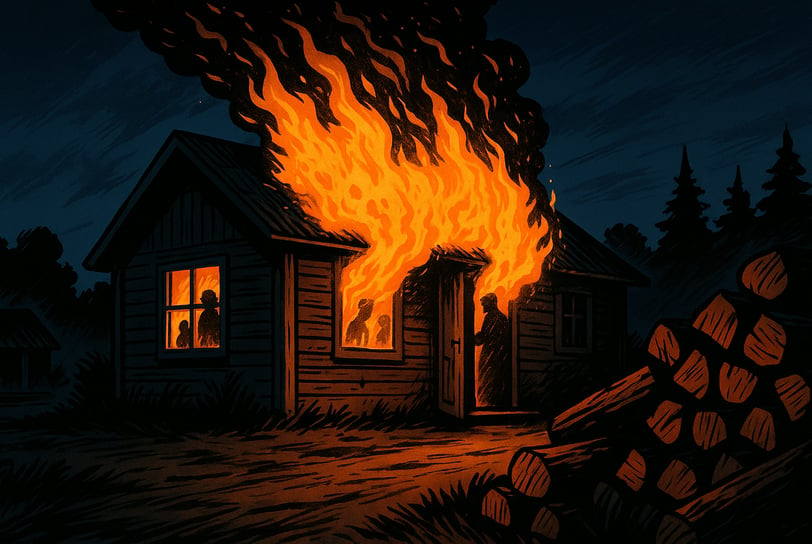The Neighbours Who Confessed: A Forgotten Double Murder in Röste
In 1950s Sweden, a brutal double murder shook the quiet village of Röste. Two neighbours confessed — but were they really guilty?


Chapter One: The Fire at Stockberg Farm
The night was calm in Röste, a quiet village nestled in the forests outside Bollnäs. It was late September 1954, and the chill of early autumn had begun to settle over the wooden cottages and gravel lanes. In the dark hours of that night, fire tore through the red farmhouse of Johan and Hilma Stockberg — a quiet, elderly couple who had lived a simple, frugal life on their smallholding.
By the time the flames had been subdued, two bodies were found amid the ash and soot. Johan, 76, and Hilma, 72 — both dead. At first, the scene appeared to be a tragic accident. But something about the way the bodies lay, the unnatural stillness, the absence of panic — suggested something far more sinister.
It didn’t take long for the whispers to begin.
When word spread that the couple’s heads bore signs of blunt trauma, and that a towel had been tied tightly around Hilma’s neck, the mood in Röste shifted from grief to fear. Had someone from outside the village done this? Or worse — was the killer one of their own?
A week later, a man was seen wandering drunkenly through the village, muttering incoherently. His name was Stig Helge Strömberg, a 33-year-old known for petty theft, low wages, and heavy drinking. He was staying nearby and had been seen on the Stockbergs’ land.
He was arrested for questioning — but vehemently denied involvement. He admitted he’d been drinking heavily and remembered little, but said: "Two words I know I never said — that I killed them."
Investigators weren’t convinced. But they were about to be led in an entirely new direction — by a neighbour with secrets of her own.
Chapter Two: Mimmi and the Confession
Her name was Vilhelmina “Mimmi” From, a poor, elderly woman who lived just across the way with her brother Oscar Myrberg. Locals remembered them as odd, isolated. Some said they were slow, others whispered about past institutions. What no one expected was what Mimmi would reveal.
In police questioning, Mimmi broke down. Over the course of seven hours, she gave a chilling account. She said she and her brother had grown angry with the Stockbergs — over small disputes, petty slights. That night, she claimed, she had crept into the house, struck both Johan and Hilma with a log of wood, and then strangled Hilma with a towel. Oscar, she said, helped carry the bodies to the kitchen, where they doused the floor with paraffin and set the place alight.
She even described how she’d gone home, placed her shoes by the fire, and told Oscar: “We’re never speaking of this again.”
Oscar, when questioned, said little — but eventually confessed too. Their story was vivid, shocking, and unflinchingly precise. But something didn’t sit right.
Chapter Three: Were They Guilty?
The trial opened in November 1954 at Bollnäs District Court. Mimmi and Oscar were escorted in under heavy guard. Photos from the time show Mimmi in a dark overcoat, eyes wild, clutching a handbag. Oscar was thin, pale, almost gaunt.
Their defence team argued that both siblings had significant intellectual disabilities and had been pressured into confessing. Psychiatrists later confirmed that Mimmi’s mental age was that of a 10-year-old. She had a history of psychiatric care. Oscar, too, showed signs of cognitive impairment.
And then came the twist: both denied the confession. At trial, they retracted everything.
Mimmi claimed she was confused, scared, and wanted to say whatever the police wanted to hear. Oscar barely spoke. Still, the court convicted them — Mimmi for the murders, Oscar for assisting in covering them up.
They were not given prison sentences, but instead committed to psychiatric care.
Chapter Four: Doubt and a New Name
The years passed. Mimmi died in 1959. Oscar in 1968. But the story didn’t fade. In the decades that followed, criminologists and legal scholars began to question the case.
Among them was Sweden’s most famous crime expert: Leif GW Persson, professor emeritus of criminology. He studied the records, reviewed the statements, and came to a controversial conclusion.
He believed neither Mimmi nor Oscar had committed the murders.
Instead, he pointed to Stig Helge Strömberg — the original suspect — as the most likely killer. A loner with a violent past and a known grudge against the Stockbergs, he had no alibi for the night in question. Persson argued that police, under pressure to solve the case, had used the From siblings' vulnerabilities against them.
“They couldn’t say no,” he told Veckans Brott. “They were made to confess.”
The Silence of Röste
Today, the house is gone. Only an empty patch of land remains where Johan and Hilma once grew vegetables and chopped wood. The case is rarely spoken of, even in Röste. But those who still remember — remember the fire, the fear, and the trial that felt more like a tragedy.
Were Mimmi and Oscar murderers? Or scapegoats sacrificed to calm a panicked community?
One thing is certain: justice never truly came to the Stockbergs — or to those accused of killing them.
